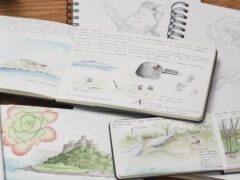Western Gull Similar Species Comparison
Main SpeciesWestern Gull
Breeding adult
Large white-headed gull with a heavy bill and pink legs. Breeding adults have a dark gray back, on orange ring around the eye, and a red spot on the lower bill.
© Jessica Hadley / Macaulay LibraryCalifornia, February 21, 2018Nonbreeding adult
Large white-headed gull with a slaty gray back. Nonbreeding birds have very little streaking on the neck, unlike other gull species of the same age.
© Mason Maron / Macaulay LibraryCalifornia, January 14, 2021Breeding adult
One of the largest gulls on the Pacific Coast of North America. Note bulky proportions, heavy bill, and dark gray back.
© Jay McGowan / Macaulay LibraryBaja California, March 06, 2014Third winter
Third-winter Western Gulls have a smudgy head and neck. Their wingtips are entirely dark, lacking the white spots seen on adults. Note the heavy bulbous-shaped bill with a dark band across the tip.
© Christoph Moning / Macaulay LibraryCalifornia, August 25, 2012Second winter
Second-winter Western Gulls have a slaty gray back and light brown mottled wings. The underparts and head are mostly white.
© Bernardo Alps / Macaulay LibraryCalifornia, April 10, 2017Second winter
Second-winter birds have a mostly white head and underparts with slaty gray feathers coming in on the back and light brown wings. Note bulbous-shaped bill and pink legs.
© Bernardo Alps / Macaulay LibraryCalifornia, February 10, 2017First winter
First-winter birds are heavily mottled in gray and brown with dark primaries. The extent of brown smudging on the breast varies among individuals. This individual has a fairly advanced molt with a whiter head and underparts.
© Peter Nguyen / Macaulay LibraryCalifornia, March 12, 2017First winter
Large gull with a heavy bulbous bill and pink legs. First-winter birds are mottled brown and white in various amounts. This individual shows considerable brown smudging on the head and underparts.
© Darren Clark / Macaulay LibraryCalifornia, October 13, 2018Juvenile
Juveniles are gray-brown below with checkered back and wings. Note pink legs, heavy bill, and large size.
© Alison Davies / Macaulay LibraryCalifornia, August 30, 2020Breeding adult
In flight, note broad wings with a narrow white trailing edge and small white spots on the outer primaries. The darker wingtips blend gradually into the slaty gray wings and back.
© Jack Rogers / Macaulay LibraryCalifornia, June 10, 2018Breeding adult
From below, note the gray secondaries and narrow white trailing edge.
© Esme Rosen / Macaulay LibraryCalifornia, April 01, 2013Juvenile
On flying juveniles note the dark tail, pale barred rump, and dark brown primaries and secondaries.
© Blake Matheson / Macaulay LibraryCalifornia, February 16, 2020Habitat
Breeds on rocky islands and forages in intertidal areas, harbors, beaches, garbage dumps, fields, and other areas with easy access to food.
© Jim Scott / Macaulay LibraryOregon, September 24, 2017Similar SpeciesHerring Gull
Nonbreeding adult (American)
Adult Herring Gulls have a paler gray back than Western Gulls. Nonbreeding adult Herrings also have more streaking on their head than nonbreeding adult Western Gulls.
© G & B / Macaulay LibraryConnecticut, October 22, 2016Similar SpeciesHerring Gull
Second winter (American)
Herring Gulls have a slimmer bill than Western Gulls, which have a more bulbous-shaped bill. Second winter gulls have paler gray feathers coming in on their back than second winter Western Gulls.
© Chris Wood / Macaulay LibraryNew York, November 08, 2015Similar SpeciesHerring Gull
Juvenile (American)
Herring Gulls have a slimmer and less bulbous-tipped bill than Western Gulls in all ages. Juveniles tend to be paler brown overall than juvenile Western Gulls.
© Evan Lipton / Macaulay LibraryMassachusetts, August 06, 2014Similar SpeciesCalifornia Gull
Breeding adult
Adult California Gulls can be separated from adult Western Gulls by their yellow legs and paler gray backs.
© Brian Sullivan / Macaulay LibraryCalifornia, August 01, 2008Similar SpeciesCalifornia Gull
Second winter
Second winter California Gulls have a slimmer and more strongly bicolored bill than second winter Western Gulls. At this age, the back feathers are also paler on California than on Western Gulls.
© Grace Oliver / Macaulay LibraryWashington, July 01, 2017Similar SpeciesCalifornia Gull
First winter
The bill on first winter California Gulls is more strongly bicolored than the bill on first winter Western Gulls. Californias also tend to have whiter heads than first winter Westerns.
© Steven Mlodinow / Macaulay LibraryBaja California Sur, March 19, 2009Similar SpeciesCalifornia Gull
Juvenile
Juvenile California Gulls have a slimmer bill that usually shows pink at the base while the bill of juvenile Western Gulls is entirely black and heavier.
© Joshua Covill / Macaulay LibraryMontana, September 25, 2017Similar SpeciesRing-billed Gull
Nonbreeding adult
Adult Ring-billed Gulls can be separated from adult Western Gulls by their smaller size, paler gray backs, yellow legs, and black band around the bill.
© Evan Lipton / Macaulay LibraryRhode Island, September 29, 2014Similar SpeciesRing-billed Gull
First winter
Immature Ring-billed Gulls are smaller than Western Gulls and have a slimmer bill, lacking the bulbous tip seen on immature Westerns.
© Brad Walker / Macaulay LibraryNew York, February 27, 2016Similar SpeciesGlaucous-winged Gull
Nonbreeding adult
Adult Glaucous-winged Gulls have pale gray wingtips unlike adult Western Gulls that have black wingtips. Glaucous-winged Gulls are also paler gray overall than Western Gulls.
© Christoph Moning / Macaulay LibraryHokkaido, February 23, 2017Similar SpeciesGlaucous-winged Gull
Second winter
Immature Glaucous-winged Gulls have paler brown wingtips than immature Western Gulls.
© Brian Sullivan / Macaulay LibraryCalifornia, December 18, 2007Compare with Similar Species
Click on an image to compare
Species in This Family
Gulls, Terns, and Skimmers(Order: Charadriiformes, Family: Laridae)
More to Read
Don't miss a thing! Join our email list
The Cornell Lab will send you updates about birds,
birding, and opportunities to help bird conservation.







































